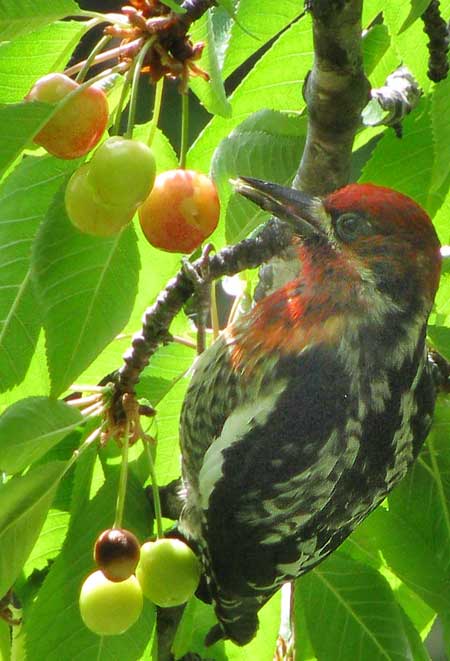Excerpts from Jim Conrad's
Naturalist Newsletter
from the October 10, 2004 Newsletter issued from the Sierra Nevada foothills
somewhat east of Placerville, California, USA
RED-BREASTED SAPSUCKERS
My old birding fieldguide makes it all very simple: There's a bird called the Yellow-bellied Sapsucker, SPHYRAPICUS VARIUS, which is fairly common from coast to coast in the US. In most of the US it's a winter bird, spending its summers in Canada and the higher elevations. You can see the species in various of its plumages by clicking on the dots at the lower, right of the picture on the Ebird.Org Red-Breasted Sapsucker page.
The only nod to a possibility that the situation may be a little more complex than described above is that my old fieldguide also shows a picture of a Yellow-bellied Sapsucker with much more than a small patch of red on the head. In that picture the whole head is red, as well as the chest. The bird looks as if it's been dipped head-first into a bucket of red paint. The guide says "Red-breasted races occur on the Pacific Slope." You can see such a red-headed sapsucker below:

Here in the Sierra Nevada foothills I see birds that look like the ordinary Yellow-breasted Sapsucker, as well as red-headed ones. Moreover, now the Internet tells me that no longer are the red-headed ones considered to be a mere race of the Yellow-breasted species. They constitute a full species all by themselves, known as Red-breasted Sapsuckers, SPHYRAPICUS RUBER -- and S. ruber is itself divided into northern and southern subspecies. Plus there's yet another sapsucker my fieldguide doesn't know about at all, the Red-naped Sapsucker, SPHYRAPICUS NUCHALIS, in the US's western mountains! You can see one of those on EBird.Org's Red-naped Sapsucker page.
How simple it all was before this genetic-sequencing business started discovering complexities in the evolution of things that we never suspected. One is glad to have "the truth," but one yearns for the old days when all the facts seemed to fit nicely into a small fieldguide fitting neatly into a pocket.